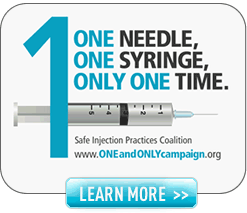HONOReform is proud to reprint board member Pam Demski-Hart’s recent contribution to the CDC’s Safe Healthcare Blog. Pam is the principal and founder of Healthcare Accreditation Resources LLC, a consulting service for ambulatory healthcare and dental facilities. She shares in this blog her personal observations of unsafe injection practices in healthcare settings. Pam discusses the differences between reality and perception when it comes to what infection control practices are — and are not. The blog is posted here in its entirety. We urge you to share with all healthcare providers, and to combat the dangerous denial of the presence of unsafe injections.
They greet me at the facility door with a handshake and a cheerful comment, “We’re pretty sure we’re OK!”
And that’s when I cringe and prepare myself.
Because many of them – even with the best of intentions – could not be more wrong.
As a consultant who has devoted the last 20 years to helping healthcare facilities meet federal, state or accreditation requirements on infection prevention and control, I’ve heard and seen just about everything.
However with each new encounter, although skeptical, I remain hopeful. I ask them to walk me through their process, from storage of medication, to preparation and administration of injections, to proper decontamination of surfaces, instrument processing, and waste and medication disposal.
Recently, I had to ask a nurse-manager to interrupt a physician performing a spinal injection. I had observed that he changed the needle but reused the same syringe to reenter the multi-dose vial. That’s a clear violation of the guidelines included in CDC’s “Guide to Infection Prevention Checklist for Outpatient Settings” (Appendix A)[PDF – 1.4 MB].
I explained to him the ramifications and outbreaks regarding unsafe injection practices. “What do you mean?” he exclaimed incredulously, “I changed the needle!” By the way, we were in an accredited facility.
Likewise, a similar interaction with a BSRN who repeatedly asked me to explain why an IV bag can’t be spiked and left for later use, even though “US Pharmacopeia (USP 2008), A General Chapter Pharmaceutical Compounding-Sterile Preparations,” recommends administering the IV no more than an hour after spiking it.
I’ve seen pressure cookers used for autoclaving in an outpatient podiatry setting and non-FDA approved dishwashers used for processing/pre-cleaning dental instruments.
And there’s the physician who, when I brought an egregious case of unsafe injection practice to his attention, said, “In this state? I know our doctors wouldn’t do that.” These instances bring to mind the response of the mid-19th century physician Charles Delucena Meigs who disputed Dr. Semmelweis’ (the pioneer of antisepsis) theories regarding the direct correlation between hand hygiene and infection prevention. Dr. Meigs stated “Doctors are gentlemen and gentlemen’s hands are clean.” Still today, and in too many instances, the “Semmelweis reflex” prevails and the mentality toward change has not improved as one would expect.
It doesn’t matter what the state the practice is in.
It doesn’t matter which part of town.
It doesn’t happen just with healthcare providers who attended less prestigious schools.
Unsafe injection practices are prevalent and dangerous. And we have the outbreaks to prove this and these are just the instances we know about or providers admit to.
Yes, there is a fair amount of “denial” about unsafe practices. Unfortunately perception and reality are often two different things.
So what do we do? How do we get beyond our perceptions that we are following correct procedure when often we are not? How do we accept the real possibility that our practices are exposing patients to life-threatening infections?
I’ll look at that in my next blog post.


